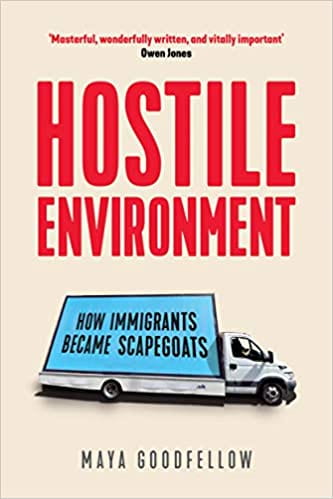Race, nation and migration – the blog series reframing thinking on movement and racism.
By Maya Goodfellow.
‘Hard Brexit,’ Labour’s Andy Burnham warned a few months after the EU referendum result in 2016, would ‘turn Britain into a place it has never been: divided, hostile, narrow-minded.’ This is a theme that has persisted since the initial aftermath of the referendum; some of the people most vocally opposed to Brexit seem to assume that this country will become or is becoming a hostile and racist place for migrants. This erases a whole history of racist and racialising thinking on immigration. My book, Hostile Environment: How Immigrants Became Scapegoats (2020, Verso) seeks to challenge this thinking, partly by showing how race and racism have long impacted and been produced by policy.
The UK’s hostile environment did not start with Brexit nor did it begin with the sets of policies introduced through the 2014 and 2016 Immigration Acts. Saying this does not mean arguing that there are no distinct, significant impacts of these more recent and punitive forms of ‘immigration control’. People are being denied access to healthcare, housing and work, their data being shared between different government departments if they cannot show they have the ‘right’ documentation to be in the UK. Even in the middle of a global pandemic, the hostile environment has largely continued.
But to imply that these policies were fundamental ruptures that made once ‘liberal’ and welcoming Britain into a place it had never been before is to ignore recent history. Britain has long been a hostile environment for migrants and people racialised as a threat.
Though it is rarely engaged with or properly understood in the public domain, there is much work examining the UK’s immigration histories. From the racist policies of the Sixties and Seventies, which were concerned with restricting the ability of people of colour from former colonies and colonies to come to this country, through to the way people were treated when they arrived. Racism and immigration policy are inseparable in so many ways.
But too often it is assumed that this relationship is mostly a relic of the past, or only discernible in deeply damaging but seemingly rare cases like the Windrush scandal. This is partly to do with how race and racism are understood: as largely isolated to individual acts, where racist sentiment is overtly expressed. In this telling, it is divorced from the material and the structural realities.
With this narrow understanding of racism as a jumping off point, the role of race in immigration policy and rhetoric is also obscured in how the debate is constructed. It is thought that anti-immigration attitudes rose during the New Labour years because the government ‘let too many people in’ without the consent of the public. Here, dislike of immigration tends to be thought of as a natural reaction to too many people of a ‘certain kind’ coming into the country. When particular groups of migrants arrive, the argument goes, they bring with them ‘cultural change’, which threatens a fabled and supposedly stable, unified British culture. This, then, produces racism and xenophobia. It is thought that to have a ‘cohesive’ society there needs to be more focus on common values and traditions, rather than social and economic emancipation. The only way to address this is to reduce immigration, in particular by reducing the number of racialised people entering the country.
This relies on a specific form of racialised thinking, which in the Eighties was dubbed the ‘new racism’. In the years preceding, ideas about ‘culture’ had really come to the forefront of the immigration debate (though it certainly wasn’t a new concept and has older roots). We can see it is about race by understanding that it is based on the thinking that particular ‘traditions’ are based on biological or ancestral difference. So too, such thinking goes, is the desire to defend those very traditions against so-called outsiders. Such an understanding and production of difference is often at the heart of conceptualisations of race.
If you look a little closer at the New Labour years, you find one of many problems with how the ‘culture’ argument is understood. As well as being deeply racialised, it is not as if anti-immigration politics flourished all on its own: it was cultivated by the Conservatives, the British National Party and eventually the UK Independence Party. New Labour were reproducing this thinking too. Almost from the get go they were anti-asylum, perpetuating stereotypes and implementing restrictive legislation. This was largely on the basis that some people were pretending to be seeking asylum and came to the UK because of so-called ‘pull factors’.
New Labour never significantly challenged the racialised thinking that some groups were a threat to the UK. Instead, they reproduced it in their own specific way: those who were Muslim or thought to be Muslim, for instance. It is against this backdrop that New Labour became increasingly critical of immigration more broadly. So the ‘cultural’ arguments against immigration are both deeply racialised and historically and politically produced; they are not some natural inevitability.
There is no rosy liberal past, then, where processes of racialisation were insignificant or rejected. Understanding this is key not only to making sense of the ways race is produced and operates in policy now but to forging a new, better world together.
Maya Goodfellow is a Leverhulme Early Career Research Fellow at Sheffield Political Economy Research Institute. Her research looks at the relationship between capitalism, racism and immigration.
Hostile Environment: How Immigrants Became Scapegoats (2020) is available from Verso with a 40% discount.


